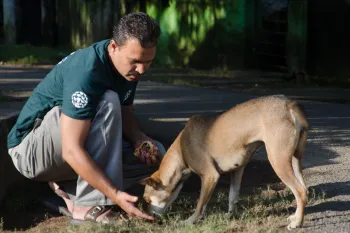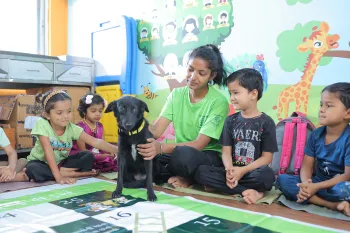When the right minds with the right motivation meet the right kind of data, many good things become possible. That’s why we were pleased by the collaboration involving team members of Humane World for Animals India (formerly called Humane Society International India) and graduate students from the Massachusetts Institute of Technology’s Sloan School of Management. Together, they developed a predictive tool to help government officials estimate street dog populations, design effective sterilization programs and ultimately save lives.
The students involved began with a compassionate, optimistic and practical premise—one shared by all of us at Humane World for Animals—that we can and should apply our best energy and intelligence to solving animal welfare challenges across a range of concerns, including street dog management.
Calls for street dog roundups generally arise from public frustration when municipal sterilization programs fail to produce results that are obvious and visible. In part, this occurs because such programs frequently operate without reliable population data, ill-defined strategic focus or poor understanding of the factors driving street dog population growth. When such programs stretch on for decades, without evident progress, it can easily fuel public dissatisfaction, media criticism and legal challenges, among other responses.
We believe it doesn’t have to be like that, and MIT graduate students Prateek Gautam and Ankur Malik have the same view. In their Analytics Capstone Project, which brings young data science specialists pursuing MBAs together with external partners to tackle real-world problems, the two analyzed more than a decade’s worth of data gathered by Humane World for Animals India on dog population numbers, sterilization rates, dog bite incidents and public complaints.
The result? A predictive online model with an easy-to-use chatbot interface that turns complex datasets into actionable insights for government officials and program managers. With a tool of this nature, authorities can forecast population trends, plan humane dog sterilization campaigns, allocate budgets more effectively, and support interventions with the greatest potential for impact.
Continuous input from our India team and government partners helped to ensure the tool was not only technically robust but also practical and relevant to the realities of street dog work. As we look toward the future, we envision this and similar tools helping to lay the foundation for more efficient, humane and evidence-driven street dog management. And that in turn will create safer, healthier communities for people and animals.
This is no trivial exercise. India is home to more than 70 million street dogs, living alongside people in every corner of the nation, and experiences nearly one-third of the world’s cases of human rabies. The majority of those cases are caused by dog bites. Each year, an estimated 17 million people in India are bitten by dogs, and between 18,000–20,000 lose their lives, accounting for 36% of global rabies deaths.
The sense of urgency that surrounds the debate over street dog management results directly from long-standing and deep-seated anxieties concerning rabies and other public safety threats associated with street dogs. This fear was underscored in a jarring manner earlier this month when the Supreme Court of India ordered the mass capture and permanent confinement of all street dogs in Delhi―a move that experts warn could undermine existing rabies control efforts and lead to greater animal suffering across the country.
Late last week, a three-judge panel, appointed by Chief Justice B.R. Gavai to assess and reconcile two apparently conflicting rulings on the subject, reserved the order, effectively postponing a decision until further notice by the court. Humane World for Animals India staff members have reached out to authorities in a series of Indian states to reinforce the point that the Supreme Court order concerning the Government of Delhi does not pertain to their jurisdictions, while renewing a long-standing offer to support Delhi through training, spay and neuter services, survey work and community engagement, the approach that has made our work in India so successful to date.
Like any early-stage analytical model, the one presented by the MIT students will require more data, more refinement, more input from participants in street dog management, and more time before it is validated for broad-scale use. Still, it demonstrates what can come from higher-order thinking applied to an expanding but largely unrefined dataset. And that’s the kind of thinking, the kind of data collection and the kind of energy we’re going to need to stabilize street dog populations not just in India but in every nation in which those dogs are present. And that’s a lot of nations.
At its heart, this collaboration shows what’s possible when innovation, expertise and compassion are united in the spirit of helping to protect both human lives and animal lives. In the world that we’re working every day to create, this kind of creativity in dealing with animal welfare challenges will spread, becoming ever more common. Wishes won’t make it so, of course, but intelligent and dedicated action will.




